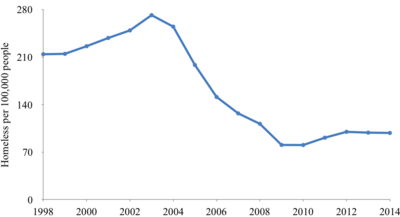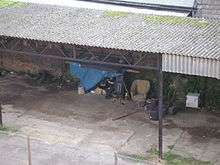Homelessness in England

In England, local authorities have duties to homeless people under Part VII of the Housing Act 1996 as amended by the Homelessness Act 2002. There are five hurdles which a homeless person must overcome in order to qualify as statutory homeless. If an applicant only needs the first three of these tests Councils still have a duty to provide intermin accommodation. However an applicant must satisfy all five for a Council to have to give an applicant "reaonable preference" on the social housing register.[1] Even if a person passes these fives tests councils have the ability to use the private rented sector to end their duty to a homeless person.[2]
The five tests are:
- Is the applicant homeless or threatened with homelessness?
- Is the applicant eligible for assistance?
- Is the applicant priority need?
- Is the applicant intentionally homeless?
- Does the applicant have a local connection?
The annual number of homeless households in England peaked in 2003-04 at 135,420 before falling to a low of 40,020 in 2009-10. In 2014-15, there were 54,430 homeless households, which was 60 per cent below the 2003-04 peak.[3]
In England, an average of 498 people sleep rough each night, with 248 of those in London.[4]
Given the costs of providing temporary accommodation and the limit amount of social housing in the United Kingdom some Councils have been criticised for attempting to circumvent their duties under the law a process which has been termed "gatekeeping". The term "Non-statutory homelessness" covers people who are considered by the local authority to be not eligible for assistance, not in priority need or "intentionally homeless".[5][6]
Reasons for homelessness
In 2007/2008, the Office of the Deputy for Homelessness Statistics produced a table which showed some of the more immediate reasons for homelessness in England.[7] These were not underlying reasons but before the onset of homelessness. These reasons were given by the minister's report for 2007/2008 as:[8]
- 37% - Parents, family, or friends no longer willing or able to accommodate
- 20% - Loss of private dwelling, including tied accommodation
- 19% - Breakdown of relationship with partner
- 4% - Mortgage arrears
- 2% - Rent arrears
- 18% - other
The longer term causes of homelessness in England have been examined by a number of research studies. These suggest that both personal factors (e.g. addictions) and structural factors (e.g. poverty) are responsible for homelessness. A number of different pathways into homelessness have been identified. [9] There are additional factors that appear to be causes of homelessness among young people, most notably needing to face the responsibilities of independent living before they are ready for them [10]
Government treatment of the homeless
Statutory Homeslessness Tests
All local authorities in England have a legal duty to provide 24-hour advice to homeless people, or those who are at risk of becoming homeless within 28 days.
A local authority must accept an application for assistance from a person seeking homelessness assistance if they have reason to believe that the person may be homeless or threatened with homelessness. They are then duty bound to make inquiries into that person's circumstances in order to decide whether a legal duty to provide accommodation and assistance is owed. "Interim accommodation" must be provided to those that may be eligible for permanent assistance pending a final decision. If the local authority decides that a person is homeless but does not fall into a priority need category, then a lesser duty shall be owed which does not extend to the provision of temporary accommodation. If the authority decides that a person is homeless and priority need but became homeless intentionally then the authority must secure that accommodation is available for such a period as will give the person reasonable time to find long term accommodation, which can extend to provision of temporary accommodation. The local authority shall in all the above cases be lawfully obliged to offer advice and assistance.
If the applicant qualifies under the five criteria (that they are not ineligible for housing, such as a person subject to immigration control; that the applicant is statutorily homeless or threatened with homelessness; that they are of 'priority need'; that the applicant is not intentionally homeless; and that the applicant has a local connection) then the local authority has a legal duty to provide accommodation for the applicant, those living with them, and any other person who it is reasonable to reside with them. However, if the applicant does not have a local connection with the district of the authority then they may be referred to another local authority with which they have a local connection (unless it is likely that the applicant would suffer violence or threats of violence in that other area).
Homelessness
A person does not have to be roofless to qualify legally as being homeless. They may be in possession of accommodation which is not reasonably tenable for a person to occupy by virtue of its affordability, condition, location, if it is not available to all members of the household, or because an occupant is at risk of violence or threats of violence which are likely to be carried out.
Eligibility
Certain categories of persons from abroad (including British citizens who have lived abroad for some time) may be ineligible for assistance under the legislation.
Priority need
People have a priority need for being provided with temporary housing (and a given a 'reasonable preference' for permanent accommodation on the Council's Housing Register) if any of the following apply:
- they are pregnant
- they have dependent children
- they are homeless because of an emergency such as a flood or a fire
- they are aged 16 or 17 (except certain care leavers [orphans, etc.] who remain the responsibility of social services)
- they are care leavers aged 18–20 (if looked after, accommodated or fostered while aged 16–17)
- they are vulnerable due to:
- old age
- a physical or mental illness
- a handicap or physical disability
- other special reason (such as a person at risk of exploitation)
- they are vulnerable as a result of
- having been in care (regardless of age)
- fleeing violence or threats of violence
- service in one of the armed forces
- having served a custodial sentence or having been remanded in custody.
Rough sleeping
The official figures for England are that an average of 498 people sleep rough each night, with 248 of those in London.[4] It is important to note that many individuals may spend only a few days or weeks sleeping rough, and so this number hides the total number of people actually affected in any one year.
Services for rough sleepers
A national service, called Streetlink, was established in 2012 to help members of the public obtain near-immediate assistance for specific rough sleepers, with the support of the Government (as housing is a devolved matter, the service currently only extends to England). Currently, the service does not operate on a statutory basis, and the involvement of local authorities is merely due to political pressure from the government and charities, with funding being provided by the government (and others) on an ad-hoc basis.
A member of the public who is concerned that someone is sleeping on the streets can report the individual's details via the Street Link website or by calling the referral line number on 0300 500 0914. Someone who finds themselves sleeping on the streets can also report their situation using the same methods. It is important to note that the Streetlink service is for those who are genuinely sleeping on the streets, and not those who may merely be begging, or ostensibly living their life on the streets despite a place to sleep elsewhere (such as a hostel or supported accommodation).
The service aims to respond within 24-hours, including an assessment of the individual circumstances and an offer of temporary accommodation for the following nights. The response typically includes a visit to the rough sleeper early in the morning that follows the day or night on which the report has been made. The service operates via a number of charities and with the assistance of local councils.
Where appropriate, rough sleepers will also be offered specialist support:
- if they have substance misuse issues, they will be referred for support from organisations such as St. Mungo's (despite the name, this is a non-religious charity)
- if they are foreign nationals with no right to access public funds in the UK, repatriation assistance will be offered, including finding accommodation in the home country, construction of support plans, and financial assistance.
The service was piloted in London, in 2010, under the title No Second Night Out, which has been gone on to become the brand name used for the service in a number of other council areas. Since the launch in 2010, a number of charities have provided the core functions of the service in London:
- Thames Reach runs the London Street Rescue Service which provides support to people sleeping on the streets of the capital,
- Broadway Outreach Teams provide services on the streets in the particular areas of Kensington and Chelsea, The City, and Heathrow Airport.
Recent trends
Localism Act
A change contained in the Localism Act give Councils greater scope to place those who are statutory homesless in private sector accommodation. Critics have argued that this masks the level of homelessness by detering people from making applications in the first place.[11]
The benefit cap, increases in private rents and the limited amount of social housing has meant that London Councils are increasingly trying to house homeless people outside London where rents are cheaper. Critics have characterised this as a form of "social cleansing".[12]
Homelessness advice
Practical advice regarding homelessness can be obtained through a number of major non-governmental organisations including,
- Citizens Advice Bureaus and some other charities also offer free legal advice in person, by telephone, or by email, from qualified lawyers and others operating on a pro bono basis
- Shelter provides extensive advice about homelessness and other housing problems on their website, and from the telephone number given there, including about rights and legal situations.
- In an emergency, a person contacts a local council.
See also
References
- ↑ http://england.shelter.org.uk/get_advice/social_housing/applying_for_social_housing/who_gets_priority
- ↑ http://www.insidehousing.co.uk/homeless-forced-into-private-rented-sector/6524606.article
- ↑ "Statutory Homelessness: April to June Quarter 2015" (PDF).
- 1 2 "Homelessness Statistics September 2007 and Rough Sleeping – 10 Years on from the Target" September 2007 Department for Communities and Local Government: London
- ↑ "About homelessness". Homeless Link. Retrieved 19 December 2012.
- ↑ "The homeless people - a priority need?". Retrieved 1 July 2015.
- ↑ Office of the Deputy Prime Minister for Homelessness Statistics, "Reasons for Homelessness in England", 2005/2006.
- ↑ "Housing needs, homelessness and lettings", UK Housing Review 2007/2008, University of York, England.
- ↑ Harding, Irving and Whowell,"Homelessness, Pathways to Exclusion and Opportunities for Intervention", 2011, The Cyrenians and Northumbria University School of Arts and Social Sciences Press.
- ↑ Harding, 2004, "Making it Work: the Keys to Success Among Young People Living Independently", 2004, Bristol: The Policy Press.
- ↑ http://www.theguardian.com/housing-network/2015/feb/27/council-gatekeeping-scandal-homeless-exposed
- ↑ http://www.rt.com/uk/189988-mothers-occupy-london-tower/
Further reading
- Angell, Ian, "No More Leaning on Lamp-posts", London School of Economics
- BBC News, "Warning over homelessness figures: Government claims that homelessness numbers have fallen by a fifth since last year should be taken with a health warning, says housing charity Shelter", Monday, 13 June, 2005
- BBC Radio 4, "No Home, a season of television and radio programmes that introduce the new homeless.", 2006
- "UK Housing Review", University of York, England
External links
- The Homelessness Code of Guidance for Local Authorities – Provides statutory guidance on Local Authority obligations towards homeless people
- Quarterly government statistics on statutory homelessness – Quarterly statistics from central government on statutory homelessness
- Statutory Homelessness Statistics, England – since 2007
- StreetLink - Government funded homeless support service and charity
